Grace notes
When the Ann Arbor Choral Union debuted on Dec. 16, 1879, the concert program paid tribute to a certain piano tuner identified as “Mr. C. Smart.”
Seems Mr. Smart came “highly recommended by Mr. Meakin as his successor in the business of tuning.” Those who knew of Mr. Meakin’s reputation, and thus desired Mr. Smart’s services, could leave orders at Andrews’ Book Store in Ann Arbor, or at the Music Store of J.P. Weiss in Detroit.
That evening an accompanist listed in the program as Professor Frieze, “president of the society,” performed on one of Mr. Smart’s finely tuned instruments for a Mr. Calvin B. Cady, conductor. Together with a pianist, organist, violoncellist, and soprano, they presented Beethoven’s “Sonata Pathetique,” Handel’s “Air,” and Mendelssohn’s “May Song,” among others. The concert took place in the M.E. Church of Ann Arbor. It was a Tuesday evening.
We know all this because someone thought to save and preserve that simple paper program dating back 135 years.
To protect and preserve
This charming little slice of history now can be found among the rich compilation of historical program books, photographs, and other collectibles in the searchable digital archive, UMS Rewind. Currently in its beta form, the website chronicles the rich legacy of the University Musical Society (UMS) through the many artists who have performed in Ann Arbor since 1879.
The images in the slideshow below were provided courtesy of UMS and can be found in an online archive via the Ann Arbor District Library.
A tour through the growing archive will reveal details of a 1973 program shared by soprano Jessye Norman and pianist Van Cliburn with the Philadelphia Orchestra; rare images of Igor Stravinsky (glasses perched on his head) rehearsing on the Hill Auditorium stage in 1964; and notes about Sergei Rachmaninoff‘s performance of “The Star-Spangled Banner” in November 1920.
“As one of the oldest arts presenters in the country, we really show a snapshot of the history of touring – of international groups, orchestral groups, recitalists, and soloists – throughout the last century,” says Liz Stover, associate programming manager at UMS. “It’s important to us to make this material accessible – accessible to ourselves as a staff, accessible to scholars and musicologists, and accessible to the community and all of our loyal audience members, many of whom have been patrons for 50-plus years.”
Deep dive
Utilizing an interface designed by Ann Arbor’s Phire Group and organized through a partnership with the Ann Arbor District Library (AADL, which still houses some of the existing content), the comprehensive project is akin to such internationally recognized archives as the New York Philharmonic, Bach Digital, and Harvard University’s digitized version of its Loeb Music Library.
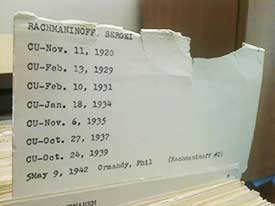
Sergei Rachmaninoff’s card in the UMS card catalogue bears no small amount of wear and tear. (Image: Michigan Today.)
But what makes UMS Rewind truly special is the breadth of artists and repertoire, Stover says. “We’re not restricted to the archive of a single orchestra or artist; we have so much work by so many different kinds of artists,” she says. “We can provide details regarding Enrico Caruso’s program in 1919 and tell you what the New York Philharmonic was playing on a specific tour in 1939.”
The UMS Rewind project has taken nearly four years to complete in close collaboration with Richard LeSueur, retired music specialist with the AADL. The time- and labor-intensive project is funded in part by a grant from the Ann Arbor Area Community Foundation (AAACF) and support from U-M.
The digital archive has been a dream of UMS for “quite some time,” says the society’s president, Ken Fischer. And the services and expertise provided by staff at U-M’s Bentley Historical Library and the AADL were invaluable in launching the site, he says.
“Whether you’re interested for academic purposes in the great performances that UMS has brought to Ann Arbor or just to revisit the 1978 program book from Vladimir Horowitz’s Hill Auditorium concert, this archive documents the legacy of UMS from its inception,” Fischer says.
“We’ve had the honor of working closely with the [AADL] over the past three years to digitize many of our archival materials preserved with great care at U-M’s Bentley Historical Library. And we are hugely grateful to the AAACF for its grant, which makes it possible for us to complete the project and create a user interface so that anyone anywhere can easily search for the information they want, ensuring the project can become a true resource not just for our local community but for the world.”
Play it again
Much like UMS itself, UMS Rewind will rely on longtime fans and volunteers to enhance its offerings. Arts lovers are encouraged to supplement existing documentation with personal anecdotes – about an artist’s encore, for example – that can help recreate the fleeting nature of these once-in-a-lifetime performances.
“Sometimes those moments that are not actually documented in a printed program can be the most meaningful part of a show,” Stover says, “and we see this as an incredible opportunity to hear from the people who were there.”
The living archive will invite comments on both historic and contemporary performances going forward. Content will include promotional videos, interviews with artists and patrons, trailers, and even the Emmy-winning documentary about Hill Auditorium, A Space for Music, a Seat for Everyone.
The site will continue to evolve, offering an increasingly sophisticated search function, robust artist pages, a photo archive that digs deeper than the current library, and linked documents that include reviews of performances, related previews, and more. The potential presentation of live recordings remains unclear however, in light of performance rights issues and other legal complexities.
Memories are made of this
For longtime UMS supporter and volunteer Karen Stutz, UMS Rewind delivers more than just entertainment history. She was dating her husband when she first encountered the organization.
“We were volunteer ushers for the 1964 UMS May Festival,” Stutz says. “It was a wonderful experience for us to search the archive and explore the music of our early days together.”For Garrett Schumann, a music journalist and doctoral candidate in music composition at U-M, the archive already has impacted his academic and professional work. “The only danger is potentially getting swept away while uncovering the UMS commissions and world premieres that happened right here in our own backyard,” he says.
Theme and variations
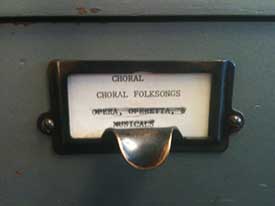
UMS keeps an extensive card catalogue detailing every performance since 1879. The new online archive is a nice step forward.(Image: Michigan Today.)
Now entering its 136th year, UMS presents 70 music, theater, and dance performances by professional touring artists each season. In addition, the society has co-commissioned work by Lukas Foss, William Bolcom, and Osvaldo Golijov. UMS has also premiered works by Michael Daugherty and Salman Rushdie, among others.
As the society prepares to launch its forthcoming season, the staff for the first time will have more than an antiquated paper-and-drawer card catalogue from which to glean and record information.
“Now that [the website] is really happening, it’s tough to have the patience to [execute] everything we want to do,” Stover says. “Overall, we’re off to a great start. The archive is always living and there will always be something new to add.”
As with any digital launch, user feedback is critical, Stover adds. UMS encourages people to explore the site and send feedback to umstix@umich.edu.
UMS is an independent non-profit affiliated with the University of Michigan.
Truly Render contributed to this story.
Top image: Jessye Norman with the Metropolitan Opera Orchestra, April 30, 1991, courtesy of UMS.




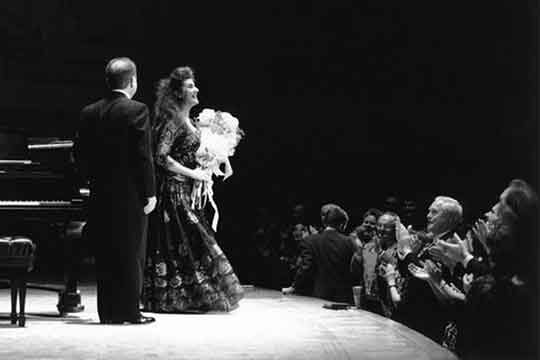
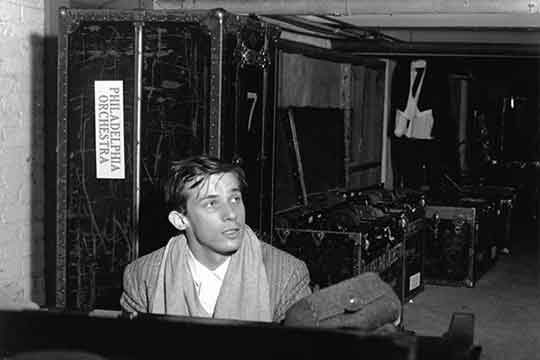
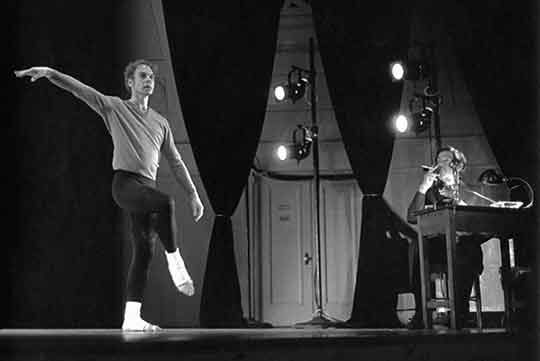

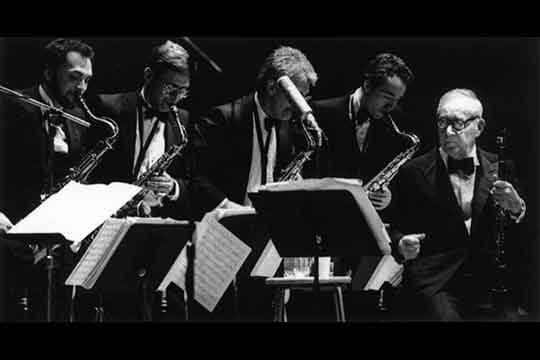
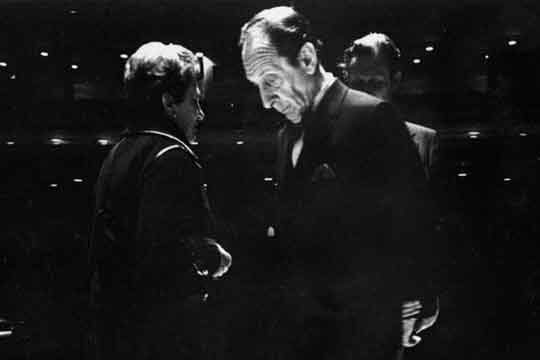

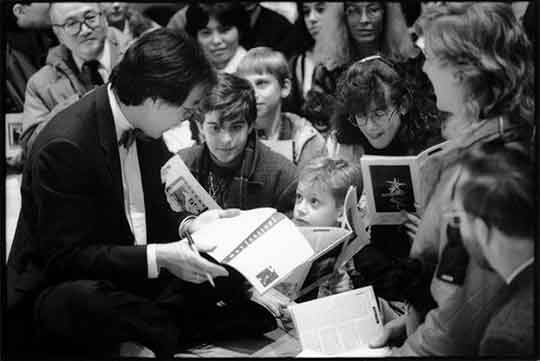

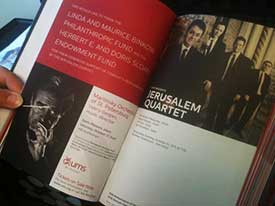


Linda Head - B Mus. 1955
This is wonderful — but I could not find a record of the music the University Choral Union sang in 1952 through 1956 (the years in which I have special interest). There are only programs for the days in which Marguerite Hood’s children’s chorus sang. Is it possible, eventually, to have a complete record of the May Festival concerts? I realize that would be a huge amount of work. (I have program books from 1952 and 1953 but no others…)
Reply
Liz Stover - 2008
Hi Linda! If you follow this link, you can see all performances by the UMS Choral Union, and I did find performances from 1952-1956. It does, however, look like some of our May Festival programs aren’t popping up. I’ll add that to my list of things to check on as I’m sure we have them digitized. The information from all of our May Festival performances is in the archive but some programs may be missing for the time being.
http://umsrewind.org/artist/ums-choral-union/
Enjoy!
Reply
Frederick E Brenner MD - Medical School 1961
Music school member of the Choral Union Choir 1950. I enlisted in the US Air Force in 1951 for 5 years then came back to Medical School in 1958. I have seen and heard many wonderful concerts. Thank you for this new opportunity to revision those great experiences.
Reply
Judith Reynolds - 1959, 1963
Huge thanks for this archive. I’m a music critic and recently referenced the May Festival performance with Leontyne Price while previewing The MET live in HD. Great memory, and now I can fill in all the other Choral Union concerts that I participated in. Thanks. JR
Reply
Gerald (Gerry) Ahronheim - 1962, 1966
As a photographer for the ‘Ensian and (occasionally) the Daily, I was granted the opportunity by Mr. Gail Rector to capture many marvelous moments in Hill Auditorium. This intro to UMS Rewind will help me date some of these memories, such as a remarkable backstage encounter with Rudolf Serkin which led to him playing an entire Beethoven sonata as an encore (!). Also, the series of photos of Igor Stravinsky at a Hill Auditorium rehearsal complements my own, one of which Mr. Stravinsky autographed for me the same day. The UMS provided me, a non-music student, with a great musical education and memoral experiences. I look forward to dipping into the archives from time to time.
Reply